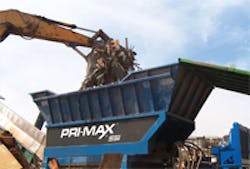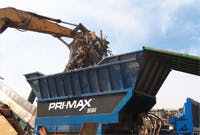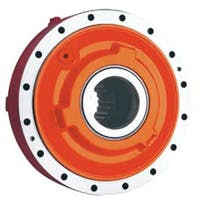Heavy Shock no Problem for Hydrostatic Drive
When a tornado, hurricane, flood, earthquake, or other natural disaster strikes, cleanup efforts can be monumental. The challenge is to convert large pieces of debris into a more manageable form. Shredding the debris cuts or shears the debris into small pieces that can be readily used as fill. In some cases, the shredded debris contains valuable materials that can be separated out magnetically, via flotation, or other sorting technique.
The challenge is to find a machine that can handle large pieces of metal, wood, and other construction materials. This is where waste reducers, from SSI Shredding Systems Inc. (SSI), Wilsonville, Oreg., come in.
The 6000T is the largest in SSI’s Pri-Max line of reducers. It is a track driven unit powered by a 700-hp diesel engine. This machine can process more than 150 tons per hour of construction and demolition waste, and even larger amounts of less-difficult municipal waste.
Cutting waste down to size
Officials at SSI make a distinction between shredding and waste reduction — primarily by the output of the machine. Shredders tend to produce relatively small pieces of material, whereas a primary waste reducer puts out larger pieces. Waste reducers also tend to be larger machines, with output measured in hundreds of tons per hour.
The operating principles are similar for both machines: a series of rotating cutters draws debris through small openings to shear it and reduce its size. In a shredder, the cutter blades overlap, typically clearing each other by 0.010 in. In a primary waste reducer, the cutters pass between fixed anvils, usually clearing by 3 to 4 in.
Hydraulics provides the muscle
“Not surprisingly, we have to deal with very high shock loading, which is a real plus for closed-circuit hydrostatic drives for the cutter shafts,” reported SSI’s Mark Fowler, senior project engineer. The heavy shock of the application could quickly wear out other types of drives, whereas the hydraulic drive is inherently tolerant of heavy shock. The 6000T uses a Parker Hannifin P30 Gold Cup piston pump with variable displacement, a maximum pressure rating of 5000 psi and maximum theoretical displacement of just under 224 gpm at 2100 rpm. It feeds two pairs of hydraulic motors, each pair mounted to either end of the cutter shafts.
As the cutters shear waste material apart, torque increases; therefore, so does hydraulic pressure. “A normal duty cycle includes one or two shifts of continuous operation with the system running at 2000 to 3000 psi about 60% of the time,” Fowler explained. The rest of the time, the machines operate at 3000 to 5000 psi to deal with tougher materials.
Fowler offered that when the reducer pulls in something really tough, the torque requirement (and, therefore, pressure) rises suddenly. The control system monitors this and reacts appropriately. Up to a point, the system simply sacrifices rotational speed for higher torque. However, if the object is too resistant, the control simply reverses the direction of rotation to lift the object and relieve the stoppage.
“Being able to monitor and control torque via system pressure is a convenient way to apply extra torque when it is needed and to protect the machine from potential damage. And the ability to instantly reverse the direction of rotation (to clear jammed material) is simply not practical with anything but a hydrostatic drive,” Fowler said.
Cool, clean and efficient
“Actually,” explained Mike Achterman, systems division manager at Hydra-Power Systems, a Parker Hannifin distributor in the Portland area, “the PR-6000T uses hydraulics for a lot more than simply powering the cutter shafts. For track-driven models, output from the hydrostatic pumps powers the track drive. They also use a hydraulic fan drive.” The hydraulic fan drive maximizes fuel efficiencywhile minimizing emissions.”
A diesel engine achieves maximum fuel efficiency while operating within a relatively narrow range of temperatures. It also produces lowest emissions per hp within a similar temperature range. So by keeping the diesel operating within a narrow range “sweet spot” of operating temperature, the hydraulic fan drive boosts fuel efficiency and cuts emissions.
Achterman added, “Powering the cooling fans hydraulically also gives SSI the freedom to put the radiator package virtually anywhere on the vehicle, which gives them a great deal of control over how the system operates. For example, they can easily program fan speed to match the actual thermal load, regardless of engine speed. You can’t do that with a belt-driven cooling fan without using a lot of maintenanceprone hardware in the system.
“They can also reverse the air flow through the radiator to blow out any debris that would otherwise impede airflow. That’s important in a setting like a landfill where the environment includes both dust and lots of lightweight debris that is easily sucked into a radiator,” Achterman said. “It’s actually pre-programmed as an automatic system function on the PR-6000.”
For more information, including videos of the PR-6000 in action, visit www.ssiworld.com.
For information on Parker Hannifin Pumps, visit www.parker.com.
For information on hydraulic motors from Hagglunds Drives, visit www.hagglunds.com.
For information on products and services from Hydra-Power systems, visit www.hydrapowersystems.com.





